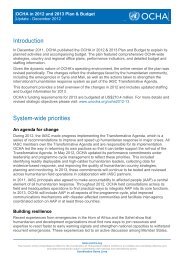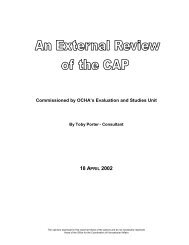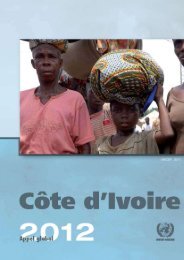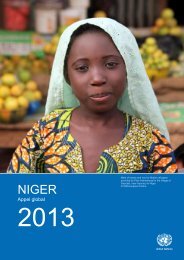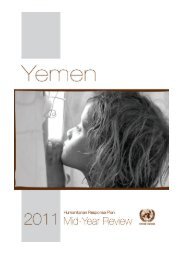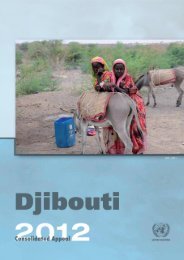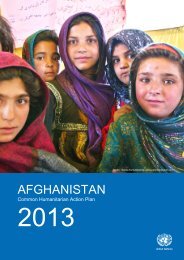SUDAN
United Nations and Partners Work Plan 2013
United Nations and Partners Work Plan 2013
- No tags were found...
Create successful ePaper yourself
Turn your PDF publications into a flip-book with our unique Google optimized e-Paper software.
United Nations and Partners[4] Sector Response Plans<strong>SUDAN</strong> WORK PLAN 201361HealthSector objectives1. To ensure better access for vulnerable populations to qualityprimary health care (PHC) services and strengthen referralsystems.2. To strengthen national, state and local capacity to predict,detect, prepare and respond to communicable diseaseoutbreaks and emergencies.3. To reduce maternal and child morbidity and mortalityamong vulnerable populations.Key sector informationLead agency World Health Organization (WHO)Government lead Ministry of HealthImplementing Almassar, ARC, CIS, COSV, CW, EMERGENCY, GOAL,agenciesHAD, HAI, HRF, IMC UK, IRW, JUH, KPHF, MercyMalaysia, MERLIN, Mubadiroon, Muslim Aid, NCA,NIDAA, OMO, PAI, PANCARE, RHF, RI,SC, Sudan RC, TOD, UNFPA, UNICEF, WHO, WorldRelief, WVS.Projects 33Beneficiaries 3,937,322Funds requested $75,383,641Funds requestedper priority levelContact infoSector needs analysisCategoryIDPs andreturneesAffectedHostcommunitiesHigh: 15 projects ($60,998,083 – 81%)Medium: 18 projects ($14,150,158 – 19%)Dr Jamshed Tanoli: tanolij@sud.emro.who.intDr Nageeb Ibrahim: ibrahimn@sud.emro.who.intRanda Merghani: merghanira@sud.emro.who.intDr. Mohamed Hussein: Kassala772@gmail.com0912690244People in needTargeted beneficiariesfFemale Male Total Female Male Total1,256,850 1,308,150 2,565,000 1,256,850 1,30,8150 2,565,0001,561,969 1,625,723 3,187,692 699,884 672,438 1,372,322Total 2,818,819 4,495,842 5,752,692 1,956,734 1,980,588 3,937,322During 2012, Sudan faced considerable health challenges andhumanitarian health needs continued to be high. This highlevel of need is symptomatic of inadequate PHC services,including for maternal and child health, as well as low healthworkforce density and the poor health status of vulnerableManagement of health facilities in DarfurFunctioning facilities, 2012Managed by facilities %1 NGOs 281 392 SMOH 433 61Total 714 100Source: WHO (2012)populations. Going into 2013, Darfur, South Kordofan, Abyei,Blue Nile State and east Sudan, remain the priority areas. Thetarget populations are IDPs, refugees, returnees and affectedhost populations in prioritised localities.Health service access and deliveryAccess to PHC services in Sudan has improved and nowreaches 80% of the population 13 . However, there are largedisparities between states, and people in urban areas arebetter served than those in rural areas. Survey results showedthat only 57.7% of households in West Darfur had access tobasic health services, compared to 65.5% in South Darfur, 78%in North Darfur and 80% in South Kordofan. The main reasonsfor limited accessibility to health care services are linked tosecurity concerns and in some instances to the distance to thehealth care facility. In addition, there are huge variations in thedistribution and quality of PHC services being provided. Forexample, the percentage of facilities providing a basic PHCpackage is 24% in Sudan as a whole, while it is 60% in Darfur,due mainly to the presence of NGOs, 18% in Blue Nile, andonly 9% in South Kordofan. Due to staff shortages, or inadequateinfrastructure, the percentage of non-functioning PHCfacilities is 14% countrywide and 28% in the Darfur region 14 .Most PHC health facilities lack minimum medical equipmentand adequate infrastructure.Human resources and information managementHuman resources for health in Sudan, especially in the Darfurregion and in South Kordofan, Blue Nile State and Abyei, arecharacterised by staff shortages and inequitable access. Thedensity of physicians, nurses and midwives is 1.23 per 1,000people against the WHO benchmark of 2.28 per 1,000 people.Health information systems in these areas are challenged byfragmentation, duplication, inadequate numbers of trainedpersonnel, and a lack of advanced communication tools andtechnologies needed for data collection, compilation andanalysis. While the Ministry of Health has developed numeroushealth policies and strategies to address such shortcomings,its ability to translate these into implementable programmes[1]714facilities[2]Health Services and Indicators DarfurMalaria incidence (per 10,000)Bloody diarrhoea incidence (per 10,000)N.DarfurS.DarfurW.Darfur20N.DarfurS.DarfurW.Darfur815610452Jan-11Feb-11Mar-11Apr-11May-11Jun-11Jul-11Aug-11Sep-11Oct-11Nov-11Dec-11Jan-12Feb-12Mar-12Apr-12May-12Jun-12Jul-12Aug-12Sep-120Jan-11Feb-11Mar-11Apr-11May-11Jun-11Jul-11Aug-11Sep-11Oct-11Nov-11Dec-11Jan-12Feb-12Mar-12Apr-12May-12Jun-12Jul-12Aug-12Sep-120Source: WHO (2012), Health Resource Availability Mapping System (HeRAMS), Early Warning and Response System (EWARS)




